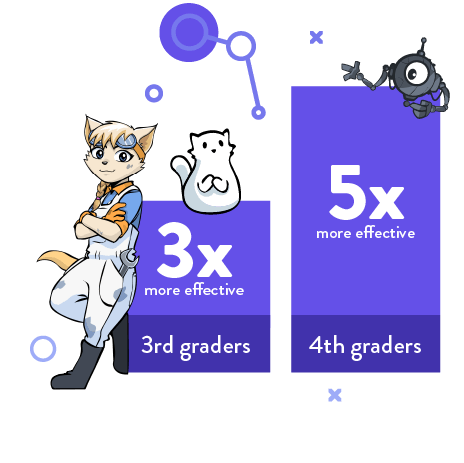The better question is, what happens if you don’t?
The fractions dilemma
Research shows that without fractions competency, students will significantly struggle in algebra and future mathematics. This critical pillar for advanced study is missing for so many students. What’s the solution?
Where math stops making sense
Meet Jacob, an elementary-aged student who, up until now, really enjoyed math. He quickly developed confidence with whole numbers—everything made sense and followed reliable patterns. After all, 2 always came after 1 when counting, and 4 was always greater than 3 when comparing. Then along came fractions.
His teacher, Ms. Garcia, introduced these mysterious fractions as “slices” (parts of a whole) and taught him some rules about what a numerator and denominator represented. Jacob even decorated his own fractions pizza box in class to practice these new concepts. But those seemingly easy rules from Ms. Garcia got really confusing really fast as Jacob encountered more complex problems. “How can I possibly find a fraction between 1/4 and 2/4?” Jacob wondered. After all, there was no pizza slice between 1 and 2…
Jacob advanced to grade 5, where he struggled to perform advanced operations such as adding and dividing fractions, making mistakes like choosing "19" as the closest number to the sum of 12/13 + 7/8 instead of "2." Then he went on to middle and high school, where algebra and new topics seemed even more confusing than slices of a pie years before. And he’s not alone.

The Frax solution: 13 hours to change a life
Do you recognize any of the students you serve in Jacob’s story? Many students like Jacob struggle to grasp fractions in elementary, which leads to serious implications later in life.
In just 13 hours, students can build a foundational understanding of fractions to dramatically impact present and future math success using ExploreLearning Frax. Led by evidence-based methods like length models and number lines, Frax is the unparalleled solution that helps students (and teachers!) develop fractions confidence through carefully scaffolded tasks. With a relatively modest investment of time (on average 13 hours to complete Frax Sector 1), students of all ability levels can succeed with fractions, creating immediate achievement gains and, more importantly, eliminating major barriers to future success and opportunity.
The new Frax White Paper underscores the crucial role of fractions in algebraic understanding and uncovers why math often “stops making sense” for students when they encounter fractions. The summary details how Frax’s adaptive and game-based platform uses research-proven strategies to guide students to fractions understanding using number lines as a central representational tool.

See the results: Elementary students who used Frax met or exceeded growth benchmarks at significantly higher rates compared to non-users.

Benefits for your teachers and students
Investing in strong fractions instruction today will save your teachers time and energy, both now and in the future. By incorporating just a few hours of Frax online and offline activities per week, students can develop a conceptual understanding of fractions that will prepare them for grade-level readiness, assessments, and future math concepts. When students understand (and enjoy!) fractions, teachers reap the cascading benefits of students who are ready for fractions instruction and excited about math, perhaps for the first time in their academic careers.
Areas of focus:
- Understanding fractions as numbers
- Fraction magnitude
- Comparing fractions
- Locating fractions on a number line
- Equivalent fractions
- Decomposing fractions
- Introductory fraction arithmetic
- Decimal notation
…and more!
For teachers:
- Frax supplements any math curriculum
- Real-time reporting
- Online and offline activities
- Professional development and lesson support materials
For students:
- Adaptive learning
- Exciting storylines and games
- Incentives to celebrate progress
- Tokens to customize their Frax experience


